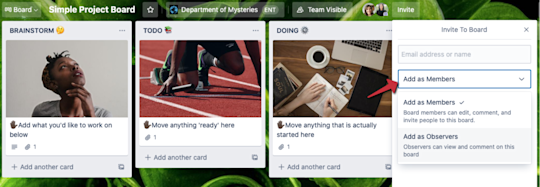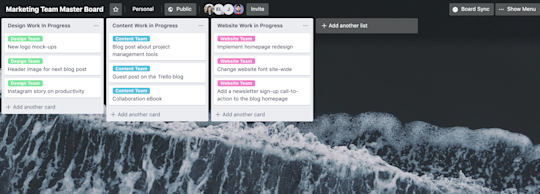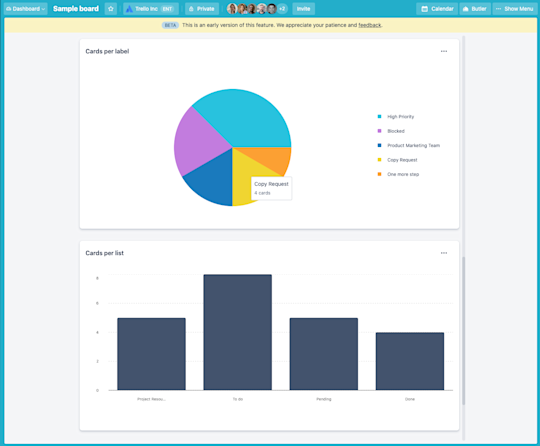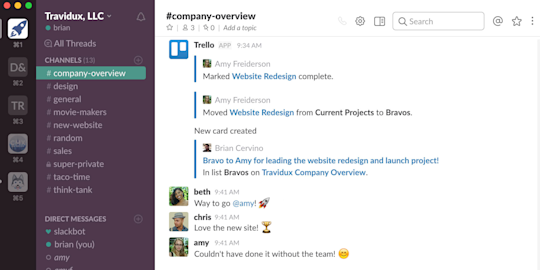Rozdział 8
Jak dostosować kokpit i widoczność raportów w Trello
Trello Enterprise ułatwia liderom i innym zainteresowanym stronom bycie na bieżąco.
O ile członkowie zespołów korzystają z Trello Enterprise do realizacji kolejnych zadań, o tyle liderzy używają Trello do zyskania wglądu w szczegółowe informacje o pracach realizowanych w całej firmie. Na szczęście Trello Enterprise ułatwia liderom i innym zainteresowanym stronom bycie na bieżąco.
Przegląd sekcji
Zagadnienia omówione w tej sekcji:
Dostarczanie danych analitycznych dla kierownictwa
Nie każdy kierownik lu interesariusz potrzebują dostępu do tej samej ilości informacji. Niektórzy liderzy preferują ogólne podsumowanie przebiegu prac nad projektami, zaś inni mogą być zainteresowani dokładniejszą analizą realizacji zadań w zespole.
Dzięki Trello Enterprise możesz dostosować sposób, w jaki przedstawiasz ważne informacje kierownikom i interesariuszom. Niezależnie od tego, czy chodzi o przyznanie dostępu do tablicy, tworzenie widoku tablicy głównej czy stworzenie niestandardowego kokpitu, mamy rozwiązanie dla każdego.
Oto kilka przykładów kierowników i potencjalnych podejść do widoczności informacji:
- Liderzy zespołów. Te osoby mogą nadzorować całą przestrzeń roboczą i potrzebują wglądu w tablice, zadania i członków w swojej przestrzeni.
- Ulepszone widoki. Widoki osi czasu i kalendarza zapewniają kierownikom zespołów wgląd w szczegółowe informacje na temat kart w obrębie danej tablicy. Widok tabeli oferuje podobny poziom szczegółowości, jednak informacje obejmują wszystkie tablice w obrębie przestrzeni roboczej.
- Raportowanie. Widok kokpitu oraz raport dotyczący przestrzeni roboczej zapewniają interaktywne wizualizacje danych oparte na wskaźnikach takich jak liczba kart na członka zespołu czy liczba kart na etykietę. Dane te można nawet wyeksportować.
- Automatyzacje. Skonfiguruj aplikację Butler, aby wysyłała automatyczne powiadomienia, gdy na tablicy podjęte zostaną określone czynności, np. jeśli karta zostanie przeniesiona na listę „Gotowe” lub dojdzie do przekroczenia terminu przypisanego do karty.
- Członkowie kierownictwa. Tacy liderzy chcą mieć pewność, że Trello pomaga zespołom realizować zadania, potrzebują więc wglądu w nakłady realizowanej pracy oraz wykorzystywane funkcje.
- Kokpity. Widok kokpitu zapewnia wgląd w konkretne wskaźniki, takie jak liczba kart na listę czy liczba kart na etykietę. Kokpity pozwalają również na generowanie raportów historycznych, dzięki czemu liderzy mogą zapoznać się ze wskaźnikami dotyczącymi dłuższych okresów.
- Raportowanie niestandardowe. Jeśli dysponujesz zasobami programistycznymi, możesz użyć otwartego interfejsu API Trello, aby stworzyć niestandardowe wywołania pozwalające na przygotowanie danych, których szukają członkowie kierownictwa.
Przypisywanie kierownikom ról obserwatorów tablic
Zachęć zewnętrznych współpracowników i inne zainteresowane strony, aby dołączyli do konkretnej tablicy. To doskonała opcja dla liderów, którzy chcą zyskać więcej informacji na temat tego, jak przebiega realizacja zadań.

Podczas przesyłania zaproszeń przypisz liderom i innym zainteresowanym stronom status obserwatora. Dzięki temu będą oni mogli zyskać wgląd w szczegóły karty i publikować komentarze w jej kanale aktywności.
Tworzenie tablic głównych
Dzięki tablicy głównej możesz synchronizować konkretne karty w przestrzeni roboczej w jednym widoku: tzw. widoku głównym. To idealne rozwiązanie dla kierowników, którzy chcą mieć centralny dostęp do określonych informacji lub po prostu wiedzieć, jakie zadania, analizy i zatwierdzenia na nich czekają.
Dodatkowa korzyść: takie rozwiązanie pozwala również znacznie szybciej przygotować aktualizacje, które chcesz przesłać w wiadomości e-mail.

Tablice główne można tworzyć za pomocą dodatku Unito Power-Up. Ta integracja stosuje synchronizację dwukierunkową, co oznacza, że wszelkie zmiany dokonane na karcie tablicy głównej zostaną odzwierciedlone na tablicy, z której pochodzi karta. Działa to również w drugą stronę.
Personalizacja widoków kokpitów
Widok kokpitu to szybki, a zarazem wydajny sposób na przekazanie dostosowanych aktualizacji kierownictwu. To doskonałe rozwiązanie dla liderów, którzy chcą mieć ogólny wgląd w kluczowe wskaźniki, a zarazem móc przyjrzeć się wybranym informacjom jeszcze dokładniej.

Wizualizacja kluczowych wskaźników, takich jak terminy, przypisane karty i liczba kart na listę, pomaga zwiększyć pewność liderów i innych zainteresowanych stron co do kierunku prac nad projektem. Liderzy mogą również łatwiej zrozumieć moce przerobowe zespołu i poznać liczbę zadań na członka zespołu.
Zyskiwanie dodatkowych danych analitycznych dzięki integracjom aplikacji
Skorzystaj z dodatków Power-Up przeznaczonych do analityki i raportowania, aby sprostać konkretnym potrzebom dotyczącymi raportowania. Możesz na przykład użyć narzędzia Dashboards by Screenful, dzięki któremu zespoły programistyczne mogą tworzyć raporty dotyczące przeszłych sprintów i wydań, a zespoły sprzedażowe mogą kontrolować informacje o potencjalnych klientach i cyklach sprzedażowych.

Powiadomienia mogą się pojawiać w narzędziach, z których korzystają liderzy i zainteresowane strony, np. w wiadomościach e-mail lub w aplikacji Slack. Możesz na przykład ustawić powiadomienia Trello w narzędziu Slack. W tym celu aktywuj dodatek Slack Power-Up. Dzięki temu można na przykład wysyłać wiadomość na konkretnym kanale Slack za każdym razem, gdy członek zespołu przeniesie kartę do listy Ukończone. Liderzy lub goście tego kanału mogą wówczas przejrzeć zapis rozmowy w narzędziu Slack i kliknąć konkretną kartę, aby dodać wymagane szczegóły.

Omówienie dostępnych opcji raportowania
Trello oferuje wiele możliwości raportowania. Niektóre z nich są dostępne w przestrzeniach roboczych, inne w kokpicie administratora wersji Enterprise, zaś niektóre można zrealizować poprzez wywołania klientów z użyciem interfejsu API Trello.
Raportowanie w przestrzeni roboczej
Raportowanie w przestrzeniach roboczych jest ograniczone do określonej przestrzeni. Obecnie nie ma możliwości raportowania dotyczącego wielu tablic w obrębie różnych przestrzeni roboczych.
- Ulepszone widoki. Widoki tabeli i osi czasu zapewniają wgląd w liczbę zadań i przypisań w obrębie pojedynczej tablicy lub wielu prac realizowanych w jednej przestrzeni roboczej.
- Raport dotyczący przestrzeni roboczej. Zyskaj szybkie zestawienie kart, których termin się zbliża lub został przekroczony, kart przydzielonych poszczególnym członkom przestrzeni roboczej oraz kart według etykiet. Dane te można wyeksportować. Aby uzyskać dostęp do raportu dotyczącego przestrzeni roboczej, wybierz opcję raportu dotyczącego wybranej przestrzeni roboczej na ekranie głównym.
Kokpit Enterprise – dziennik audytu
Wyświetlaj i eksportuj informacje o aktywności administratorów wersji Enterprise dzięki opcji Dziennik audytu w bocznym menu kokpitu administratora wersji Enterprise. Czynności przedstawione w dzienniku audytu obejmują między innymi zmiany członkostwa, zmiany w uprawnieniach i ustawieniach w obrębie całego Enterprise oraz administrowanie dodatkami Power-Up.
Niestandardowe raportowanie z użyciem interfejsu API
Współpracujesz z programistą? Zapoznaj się z możliwościami niestandardowego raportowania w odniesieniu do wszystkich punktów końcowych Trello dzięki naszemu interfejsowi API.
- https://developer.atlassian.com/cloud/trello/rest/
- https://developer.atlassian.com/cloud/trello/
- https://glitch.com/edit/#!/webhook-all-the-things?path=README.md%3A1%3A0
Teraz, gdy już znasz kilka sposobów na informowanie liderów, czas dowiedzieć się więcej na temat administratorów wersji Enterprise oraz ich kokpitów.